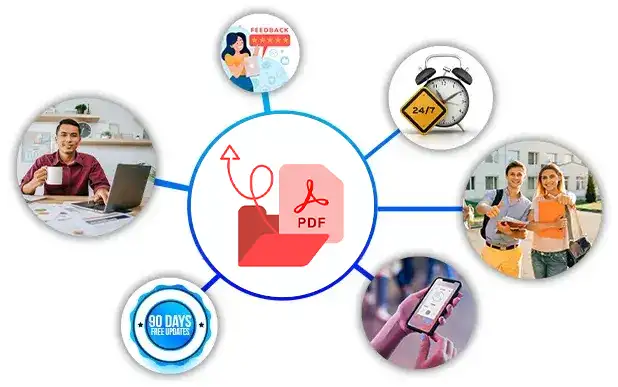Appian ACD101 PDF Exam Questions:
How to Get Success in Appian ACD101 Exam:
- Avoid deceptive ACD101 PDF Exam Questions.
- Focus on ACD101 Questions (PDF) based on the latest exam syllabus.
- Make notes of Appian ACD101 PDF for better learning.
- Prepare from our latest Appian ACD101 PDF file and get success in first attempt.


Prepare Appian ACD101 Exam Within Short Time
Your knowledge and abilities are validated by passing the Appian ACD101 exam. Our PDF questions and answers will help you prepare for the ACD101 exam in a short time because it includes questions similar to the real Appian exam questions. After downloading the ACD101 Appian PDF exam questions, relevant to the actual exam, you can take a print of all questions and prepare them anytime, anywhere.
Realistic Scenario Based Appian ACD101 PDF Exam Questions:
Everyone wants to become certified Appian Certification Program and improve his/her resume. You should practice with real ACD101 questions. Students can benefit from the ACD101 exam questions which are available in PDF format. The ACD101 exam questions and answers are designed to match the criteria of the actual exam. If you use scenario-based Appian ACD101 questions you will have an extra potential to clear the exam on the first attempt.
A customer wants to display a small toolbar with three icons - a "sad face," a "face with neutral expression," and a "happy face" - on the bottom of every page in their application.
Users will be instructed to use the icon that best expresses their current experience using the application. This will allow the customer to collect valuable data about users.
Which object type should be called from each page to implement this feature?
See the explanation below.
In Appian, interfaces are used to design and render user interface elements, allowing for the creation of custom layouts and components that can interact with users. In this scenario, the toolbar with emotion icons is a UI element that needs to be consistently presented across various pages. Using an interface ensures that these icons can be interactively used by users to express their sentiments, and the data collected can be analyzed for user experience insights. Interfaces are capable of embedding such UI elements and can be invoked or included across multiple pages within an application, making them the ideal choice for this requirement. Reference:
Appian Documentation on Interfaces: Provides detailed guidance on how to design and use interfaces to create user-centric UI components.
You select the "Generate groups and folders to secure and organize objects" option while creating a new application, Acme, with the prefix ACM.
By default, which two groups are generated by Appian? (Choose two.)
See the explanation below.
When creating a new application in Appian and opting to generate groups and folders for organization and security, Appian automatically creates specific groups to facilitate application development and management. The default groups include 'Administrators' and 'Designers' with the application prefix, in this case, ACM. The ACM Administrators group is intended for users who will have full control over the application, including configuration and deployment aspects. The ACM Designers group is designated for users primarily involved in the design and development of the application, granting them necessary permissions to create and modify application components without full administrative privileges. Reference:
Appian Documentation on Application Design: Offers insights into best practices for structuring and securing Appian applications, including the use of groups for effective application management.
You need to remove an unused field from an existing record type Product, which has data sync enabled and is backed by a database table.
What should you do?
See the explanation below.
In Appian, when dealing with a record type that has data sync enabled and is backed by a database table, changes to the structure of the underlying data model, such as removing a field, should be carefully managed. The correct approach involves deleting the unused field from the Custom Data Type (CDT) that defines the structure of the data for the record type. Following this change, a full resynchronization of the record type is necessary to ensure that the changes in the CDT are reflected in the record type and its associated data in Appian. This process ensures data integrity and consistency across the application and the database. Reference:
Appian Documentation on Data Management: Provides guidelines on managing data structures, including CDTs and record types, within Appian applications.
You have a record action that should only be visible to certain users under conditions specified by an expression.
How should you configure this?
See the explanation below.
To control the visibility of a record action based on certain user conditions or expressions, the security settings of the record action itself must be configured. This involves defining conditions or expressions within the record action's security settings that evaluate whether a user meets the criteria to see and interact with the action. This method allows for dynamic control over the accessibility of actions based on user roles, specific attributes, or other contextual factors, ensuring that only authorized users can see and execute the action under specified conditions. Reference:
Appian Documentation on Record Actions: Details how to configure and secure record actions, including visibility and permissions, to tailor the user experience within record views.
Which Appian feature is used to automate repetitive manual tasks such as extracting data from a system for which there is no API?
See the explanation below.
Robotic Process Automation (RPA) is the Appian feature designed to automate repetitive manual tasks, especially in scenarios where interacting with systems without APIs is necessary. RPA bots can mimic human actions, such as navigating through system interfaces, extracting data, and entering information, effectively bridging the gap between digital processes and systems that lack API integrations. This capability is particularly useful for integrating legacy systems into modern workflows, streamlining operations that would otherwise require manual intervention. Reference:
Appian Documentation on RPA: Explains how RPA can be leveraged within Appian to automate tasks, providing examples and best practices for implementing RPA bots in business processes.
Reliable Source Of Preparation For Appian Associate Developer Exam.
We provide Appian Certification Program certification questions along with answers to assist students in passing the Appian Exam. You can enhance your Appian ACD101 preparation with the help of an online practice engine. Try out our Appian ACD101 questions because 98% of Examskit users passed the final ACD101 exam in one go.
